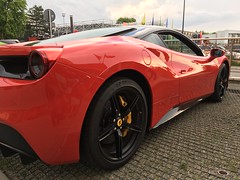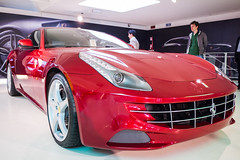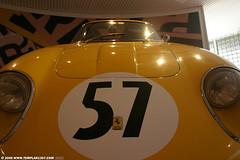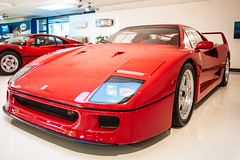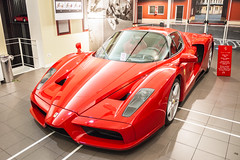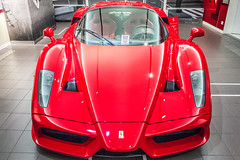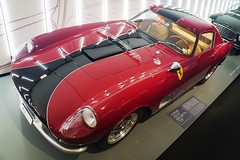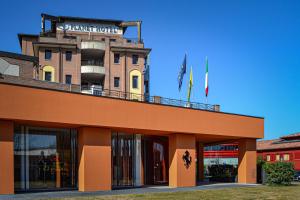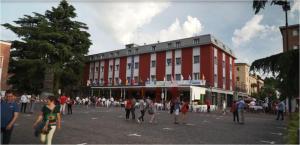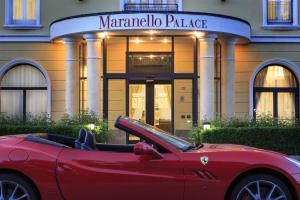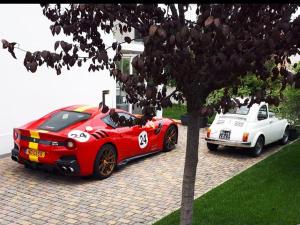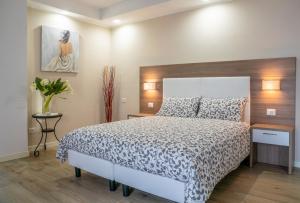Ferrari
Ferrari S.p.A. (English: /fəˈri/; Italian: [ferˈraːri]) is an Italian luxury sports car manufacturer based in Maranello, Italy. Founded by Enzo Ferrari (1898–1988) in 1939 from the Alfa Romeo racing division as Auto Avio Costruzioni, the company built its first car in 1940, and produced its first Ferrari-badged car in 1947.
Fiat S.p.A. acquired 50% of Ferrari in 1969 and expanded its stake to 90% in 1988. In October 2014, Fiat Chrysler Automobiles (FCA) announced its intentions to separate Ferrari S.p.A. from FCA; as of the announcement FCA owned 90% of Ferrari. The separation began in October 2015 with a restructuring that established Ferrari N.V. (a company incorporated in the Netherlands) as the new holding company of the Ferrari S.p.A. group, and the subsequent sale by FCA of 10% of the shares in an IPO and concurrent listing of common shares on the New York Stock Exchange. Through the remaining steps of the separation, FCA's interest in Ferrari's business was distributed to shareholders of FCA, with 10% continuing to be owned by Piero Ferrari. The spin-off was completed on the 3rd of January 2016.
Throughout its history, the company has been noted for its continued participation in racing, especially in Formula One, where it is the oldest and most successful racing team, holding the most constructors' championships (16) and having produced the highest number of drivers' championship wins (15). Ferrari road cars are generally seen as a symbol of speed, luxury and wealth. Ferrari cars are built at the 165,000 square-metre (16.5-hectare) Maranello factory. In 2014 Ferrari was rated the world's most powerful brand by Brand Finance. As of 2021, Ferrari is the 10th-largest car manufacturer by market capitalisation, with $52.21 billion.
History
Enzo Ferrari was not initially interested in the idea of producing road cars when he formed Scuderia Ferrari in 1929, with headquarters in Modena. Scuderia Ferrari (pronounced Italian: [skudeˈriːa]) literally means "Ferrari Stable" and is usually used to mean "Team Ferrari". Ferrari bought, prepared, and fielded Alfa Romeo racing cars for gentleman drivers, functioning as the racing division of Alfa Romeo. In 1933, Alfa Romeo withdrew its in-house racing team and Scuderia Ferrari took over as its works team: the Scuderia received Alfa's Grand Prix cars of the latest specifications and fielded many famous drivers such as Tazio Nuvolari and Achille Varzi. In 1938, Alfa Romeo again brought its racing operation in-house, forming Alfa Corse in Milan and hired Enzo Ferrari as manager of the new racing department; thereby disbanding the Scuderia Ferrari.
In September 1939, Ferrari left Alfa Romeo under the provision he would not use the Ferrari name in association with races or racing cars for at least four years. A few days later he founded Auto Avio Costruzioni, with headquarters in the facilities of the old Scuderia Ferrari. The new company ostensibly produced machine tools and aircraft accessories. In 1940, Ferrari produced a racing car – the Tipo 815, based on a Fiat platform. It was the first Ferrari car and debuted at the 1940 Mille Miglia, but due to World War II it saw little competition. In 1943, the Ferrari factory moved to Maranello, where it has remained ever since. The factory was bombed by the Allies and subsequently rebuilt including works for road car production.
The first Ferrari-badged car was the 1947 125 S, powered by a 1.5 L V12 engine; Enzo Ferrari reluctantly built and sold his automobiles to fund Scuderia Ferrari.
The Scuderia Ferrari name was resurrected to denote the factory racing cars and distinguish them from those fielded by customer teams.
In 1960, the company was restructured as a public corporation under the name SEFAC S.p.A. (Società Esercizio Fabbriche Automobili e Corse).
Early in 1969, Fiat took a 50% stake in Ferrari. An immediate result was an increase in available investment funds, and work started at once on a factory extension intended to transfer production from Fiat's Turin plant of the Ferrari-engined Fiat Dino. New model investment further up in the Ferrari range also received a boost.
In 1988, Enzo Ferrari oversaw the launch of the Ferrari F40, the last new Ferrari launched before his death later that year. In 1989, the company was renamed Ferrari S.p.A. From 2002 to 2004, Ferrari produced the Enzo, their fastest model at the time, which was introduced and named in honour of the company's founder, Enzo Ferrari. It was to be called the F60, continuing on from the F40 and F50, but Ferrari was so pleased with it, they called it the Enzo instead. It was initially offered to loyal and recurring customers, each of the 399 made (minus the 400th which was donated to the Vatican for charity) had a price tag of $650,000 apiece (equivalent to £400,900).
On 15 September 2012, 964 Ferrari cars worth over $162 million (£99.95 million) attended the Ferrari Driving Days event at Silverstone Circuit and paraded round the Silverstone Circuit setting a world record.
Ferrari's former CEO and Chairman, Luca di Montezemolo, resigned from the company after 23 years, who was succeeded by Amedeo Felisa and finally on 3 May 2016 Amedeo resigned and was succeeded by Sergio Marchionne, CEO and Chairman of Fiat Chrysler Automobiles, Ferrari's parent company. In July 2018, Marchionne was replaced by board member Louis Camilleri as CEO and by John Elkann as chairman.
On 29 October 2014, the FCA group, resulting from the merger between manufacturers Fiat and Chrysler, announced the split of its luxury brand, Ferrari. The aim was to turn Ferrari into an independent brand, 10% of whose stake would be sold in an IPO in 2015. Ferrari officially priced its initial public offering at $52 a share after the market close on 20 October 2015.
On 10 December 2020, CEO Louis Camilleri announced that he will step down as CEO and chairman John Elkann will step in to the Interim CEO role until a permanent successor is selected.
On 9 June 2021, the company announced the appointment of Benedetto Vigna from Geneva-based STMicroelectronics as its next CEO starting September.
Road cars
The first vehicle made with the Ferrari name was the 125 S. Only two of this small two-seat sports/racing V12 car were made. In 1949, the 166 Inter was introduced marking the company's significant move into the grand touring road car market. The first 166 Inter was a four-seat (2+2) berlinetta coupe with body work designed by Carrozzeria Touring Superleggera. Road cars quickly became the bulk of Ferrari sales.
The early Ferrari cars typically featured bodywork designed and customised by independent coachbuilders such as Pininfarina, Scaglietti, Zagato, Vignale and Bertone.
The original road cars were typically two-seat front-engined V12s. This platform served Ferrari very well through the 1950s and 1960s. In 1968 the Dino was introduced as the first two-seat rear mid-engined Ferrari. The Dino was produced primarily with a V6 engine, however, a V8 model was also developed. This rear mid-engine layout would go on to be used in many Ferraris of the 1980s, 1990s and to the present day. Current road cars typically use V8 or V12 engines, with V8 models making up well over half of the marque's total production. Historically, Ferrari has also produced flat 12 engines.
For a time, Ferrari built 2+2 versions of its mid-engined V8 cars. Although they looked quite different from their 2-seat counterparts, both the GT4 and Mondial were closely related to the 308 GTB.
Ferrari entered the mid-engined 12-cylinder fray with the Berlinetta Boxer in 1973. The later Testarossa (also mid-engined 12 cylinders) remains one of the most popular and famous Ferrari road cars of all time.
The company has also produced several front-engined 2+2 cars, culminating in the recent V12 model Lusso and V8 models Roma, Portofino and Lusso T. The California is credited with initiating the popular current model line of V8 front-engined 2+2 grand touring performance sports cars.
Starting in the early 2010s with the LaFerrari, the focus was shifted away from the use of independent coach builders to what is now the standard, Ferrari relying on in-house design from the Centro Stile Ferrari for the design of all its road cars.
Current models
| Model | Calendar year introduced | Current model | Vehicle description | ||
|---|---|---|---|---|---|
| Introduction | Update/facelift | ||||
| 812 Superfast | 2017 | 2017 | – | Front mid-engine, rear-wheel-drive grand tourer. | |
| Portofino M | 2017 | 2017 | 2021 | Retractable hardtop convertible grand tourer. | |
| Monza SP1 | 2019 | 2019 | – | Limited production single-seater sports car, part of the new Icona range. | |
| Monza SP2 | 2019 | 2019 | – | Limited production two-seater sports car, part of the new Icona range. | |
| F8 | 2019 | 2019 | – | Mid-engine sports car that replaced the Ferrari 488. | |
| SF90 Stradale | 2019 | 2019 | – | Mid-engine, plug-in hybrid sports car. | |
| Roma | 2020 | 2020 | – | Grand tourer sports car. | |
| 296 GTB | 2022 | 2022 | – | Mid-engine, plug-in hybrid sports car. | |
| Daytona SP3 | 2022 | 2022 | – | Limited production mid-engine sports car, part of the new Icona range. | |
| Purosangue | 2022 | 2023 | – | Ferrari's first SUV; uses the same platform as the Roma. | |
Customization
In the 1950s and 1960s, clients often personalized their vehicles as they came straight from the factory. This philosophy added to the mystique of the brand. Every Ferrari that comes out of Maranello is built to an individual customer's specification. In this sense, each vehicle is a unique result of a specific client's desire.
Ferrari formalized this concept with its earlier Carrozzeria Scaglietti programme. The options offered here were more typical such as racing seats, rearview cameras, and other special trim. In late 2011, Ferrari announced a significant update of this philosophy. The Tailor Made programme allows clients to work with designers in Maranello to make decisions at every step of the process. Through this program almost any trim, any exterior color or any interior material is possible. The program carries on the original tradition and emphasizes the idea of each car being unique.
Supercars
The 1984 288 GTO may be considered the first…
Hotels Ferrari
Looking for places related to Ferrari?
Those are other destinations to find places related to Ferrari:
- Monte Cimone
- Ferrari
- Appennino Tosco-Emi…
- Modena Cathedral
- Canossa Castle
- Fiorano Circuit
- Towers of Bologna
- Basilica of San Dom…
- Fountain of Neptune…
- Archiginnasio of Bo…
- Basilica di Santa M…
- San Giovanni Evange…
- Stadio Renato Dall'…
- Bologna Cathedral
- Bologna massacre
- Nonantola Abbey
- Teatro all'antica
- Bologna Guglielmo M…
- Palazzo Poggi
- Taro
- Panaro
- Giotto's Campanile
- Marzabotto massacre
- International museu…




